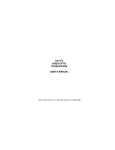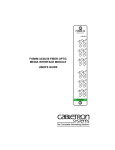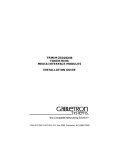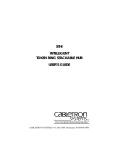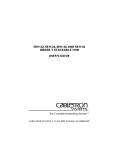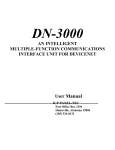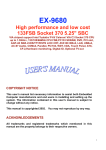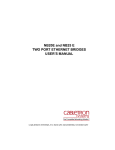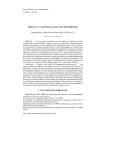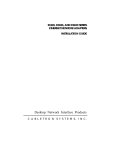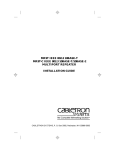Download Cabletron Systems STH-24 User`s guide
Transcript
STH-22/-24/-42/-44 STACKABLE TOKEN RING HUB USER’S GUIDE CABLETRON SYSTEMS, P. O. Box 5005, Rochester, NH 03866-5005 NOTICE NOTICE Cabletron Systems reserves the right to make changes in specifications and other information contained in this document without prior notice. The reader should in all cases consult Cabletron Systems to determine whether any such changes have been made. The hardware, firmware, or software described in this manual is subject to change without notice. IN NO EVENT SHALL CABLETRON SYSTEMS BE LIABLE FOR ANY INCIDENTAL, INDIRECT, SPECIAL, OR CONSEQUENTIAL DAMAGES WHATSOEVER (INCLUDING BUT NOT LIMITED TO LOST PROFITS) ARISING OUT OF OR RELATED TO THIS MANUAL OR THE INFORMATION CONTAINED IN IT, EVEN IF CABLETRON SYSTEMS HAS BEEN ADVISED OF, KNOWN, OR SHOULD HAVE KNOWN, THE POSSIBILITY OF SUCH DAMAGES. © Copyright February 1996 by: Cabletron Systems, Inc. P.O. Box 5005, Rochester, NH 03866-5005 All Rights Reserved Printed in the United States of America Order Number: 9031319 February 1996 STH, HubSTACK, and MicroMMAC are trademarks of Cabletron Systems, Inc. SPECTRUM, LANVIEW, and Remote LANVIEW, are registered trademarks of Cabletron Systems, Inc. IBM is a registered trademark of International Business Machines Corporation. CompuServe is a registered trademark of CompuServe, Inc. DEC and VT100 are trademarks of Digital Equipment Corporation. Windows is a registered trademark of Microsoft Corporation. Printed On Recycled Paper iii NOTICE FCC Notice This device complies with Part 15 of the FCC rules. Operation is subject to the following two conditions: (1) this device may not cause harmful interference, and (2) this device must accept any interference received, including interference that may cause undesired operation. NOTE: This equipment has been tested and found to comply with the limits for a Class A digital device, pursuant to Part 15 of the FCC rules. These limits are designed to provide reasonable protection against harmful interference when the equipment is operated in a commercial environment. This equipment uses, generates, and can radiate radio frequency energy and if not installed in accordance with the operator’s manual, may cause harmful interference to radio communications. Operation of this equipment in a residential area is likely to cause interference in which case the user will be required to correct the interference at his own expense. WARNING: Changes or modifications made to this device which are not expressly approved by the party responsible for compliance could void the user’s authority to operate the equipment. DOC Notice This digital apparatus does not exceed the Class A limits for radio noise emissions from digital apparatus set out in the Radio Interference Regulations of the Canadian Department of Communications. Le présent appareil numérique n’émet pas de bruits radioélectriques dépassant les limites applicables aux appareils numériques de la class A prescrites dans le Règlement sur le brouillage radioélectrique édicté par le ministère des Communications du Canada. iv NOTICE CABLETRON SYSTEMS, INC. PROGRAM LICENSE AGREEMENT IMPORTANT: Agreement. Before utilizing this product, carefully read this License This document is an agreement between you, the end user, and Cabletron Systems, Inc. (“Cabletron”) that sets forth your rights and obligations with respect to the Cabletron software program (the “Program”) contained in this package. The Program may be contained in firmware, chips or other media. BY UTILIZING THE ENCLOSED PRODUCT, YOU ARE AGREEING TO BECOME BOUND BY THE TERMS OF THIS AGREEMENT, WHICH INCLUDES THE LICENSE AND THE LIMITATION OF WARRANTY AND DISCLAIMER OF LIABILITY. IF YOU DO NOT AGREE TO THE TERMS OF THIS AGREEMENT, PROMPTLY RETURN THE UNUSED PRODUCT TO THE PLACE OF PURCHASE FOR A FULL REFUND. CABLETRON SOFTWARE PROGRAM LICENSE 1. LICENSE. You have the right to use only the one (1) copy of the Program provided in this package subject to the terms and conditions of this License Agreement. You may not copy, reproduce or transmit any part of the Program except as permitted by the Copyright Act of the United States or as authorized in writing by Cabletron. 2. OTHER RESTRICTIONS. You may not reverse engineer, decompile, or disassemble the Program. 3. APPLICABLE LAW. This License Agreement shall be interpreted and governed under the laws and in the state and federal courts of New Hampshire. You accept the personal jurisdiction and venue of the New Hampshire courts. v NOTICE EXCLUSION OF WARRANTY AND DISCLAIMER OF LIABILITY 1. EXCLUSION OF WARRANTY. Except as may be specifically provided by Cabletron in writing, Cabletron makes no warranty, expressed or implied, concerning the Program (including Its documentation and media). CABLETRON DISCLAIMS ALL WARRANTIES, OTHER THAN THOSE SUPPLIED TO YOU BY CABLETRON IN WRITING, EITHER EXPRESS OR IMPLIED, INCLUDING BUT NOT LIMITED TO IMPLIED WARRANTIES OF MERCHANTABLITY AND FITNESS FOR A PARTICULAR PURPOSE, WITH RESPECT TO THE PROGRAM, THE ACCOMPANYING WRITTEN MATERIALS, AND ANY ACCOMPANYING HARDWARE. 2. vi NO LIABILITY FOR CONSEQUENTIAL DAMAGES. IN NO EVENT SHALL CABLETRON OR ITS SUPPLIERS BE LIABLE FOR ANY DAMAGES WHATSOEVER (INCLUDING, WITHOUT LIMITATION, DAMAGES FOR LOSS OF BUSINESS, PROFITS, BUSINESS INTERRUPTION, LOSS OF BUSINESS INFORMATION, SPECIAL, INCIDENTAL, CONSEQUENTIAL, OR RELIANCE DAMAGES, OR OTHER LOSS) ARISING OUT OF THE USE OR INABILITY TO USE THIS CABLETRON PRODUCT, EVEN IF CABLETRON HAS BEEN ADVISED OF THE POSSIBILITY OF SUCH DAMAGES. BECAUSE SOME STATES DO NOT ALLOW THE EXCLUSION OR LIMITATION OF LIABILITY FOR CONSEQUENTIAL OR INCIDENTAL DAMAGES, OR ON THE DURATION OR LIMITATION OF IMPLIED WARRANTEES IN SOME INSTANCES THE ABOVE LIMITATIONS AND EXCLUSIONS MAY NOT APPLY TO YOU. NOTICE UNITED STATES GOVERNMENT RESTRICTED RIGHTS The enclosed product (a) was developed solely at private expense; (b) contains “restricted computer software” submitted with restricted rights in accordance with Section 52227-19 (a) through (d) of the Commercial Computer Software Restricted Rights Clause and its successors, and (c) in all respects is proprietary data belonging to Cabletron and/or its suppliers. For Department of Defense units, the product is licensed with “Restricted Rights” as defined in the DoD Supplement to the Federal Acquisition Regulations, Section 52.227-7013 (c) (1) (ii) and its successors, and use, duplication, disclosure by the Government is subject to restrictions as set forth in subparagraph (c) (1) (ii) of the Rights in Technical Data and Computer Software clause at 252.227-7013. Cabletron Systems, Inc., 35 Industrial Way. Rochester, New Hampshire 03866 vii CONTENTS CONTENTS CHAPTER 1 INTRODUCTION 1.1 Using This Manual. . . . . . . . . . . . . . . . . . . . . . . . . . . . . . 1-1 1.2 STH Overview . . . . . . . . . . . . . . . . . . . . . . . . . . . . . . . . . 1-1 1.2.1 LANVIEW LEDs . . . . . . . . . . . . . . . . . . . . . . . . . 1-3 1.2.2 TCU Ports . . . . . . . . . . . . . . . . . . . . . . . . . . . . . . . 1-3 1.2.3 Automatic Beacon Recovery Process . . . . . . . . 1-4 1.2.4 Support for Passive MAU Workgroups . . . . . . 1-4 1.3 Related Manuals. . . . . . . . . . . . . . . . . . . . . . . . . . . . . . . . 1-5 1.4 Getting Help . . . . . . . . . . . . . . . . . . . . . . . . . . . . . . . . . . . 1-7 CHAPTER 2 REQUIREMENTS & SPECIFICATIONS 2.1 General Considerations. . . . . . . . . . . . . . . . . . . . . . . . . . 2-1 2.2 Cable Specifications . . . . . . . . . . . . . . . . . . . . . . . . . . . . . 2-3 2.3 UTP Cabling Specifications . . . . . . . . . . . . . . . . . . . . . . 2-3 2.3.1 UTP Cable Categories . . . . . . . . . . . . . . . . . . . . . 2-3 2.3.2 UTP Lobe Lengths . . . . . . . . . . . . . . . . . . . . . . . . 2-5 2.4 STP Cabling Specifications . . . . . . . . . . . . . . . . . . . . . . . 2-5 2.4.1 STP Cable Categories. . . . . . . . . . . . . . . . . . . . . . 2-6 2.4.2 STP Lobe Lengths. . . . . . . . . . . . . . . . . . . . . . . . . 2-6 2.5 TCU Specifications. . . . . . . . . . . . . . . . . . . . . . . . . . . . . . 2-7 2.6 Operating Specifications . . . . . . . . . . . . . . . . . . . . . . . . . 2-8 2.6.1 Ring Speed . . . . . . . . . . . . . . . . . . . . . . . . . . . . . . 2-8 2.6.2 Ring Sequence. . . . . . . . . . . . . . . . . . . . . . . . . . . . 2-9 2.6.3 Power Supply Requirements . . . . . . . . . . . . . . . 2-9 2.6.4 Environmental Requirements . . . . . . . . . . . . . 2-10 2.6.5 Safety . . . . . . . . . . . . . . . . . . . . . . . . . . . . . . . . . . 2-10 2.6.6 Physical . . . . . . . . . . . . . . . . . . . . . . . . . . . . . . . . 2-10 ix CONTENTS CHAPTER 3 INSTALLATION 3.1 Unpacking the STH . . . . . . . . . . . . . . . . . . . . . . . . . . . . . 3-1 3.2 Installing the STH . . . . . . . . . . . . . . . . . . . . . . . . . . . . . . 3-1 3.2.1 Rack Mount or Wall Mount Hardware. . . . . . . 3-1 3.2.2 Adding the STH to a Stack . . . . . . . . . . . . . . . . . 3-2 3.2.3 Attaching the Strain Relief Bracket . . . . . . . . . . 3-3 3.2.4 Rack-Mounting the STH . . . . . . . . . . . . . . . . . . . 3-3 3.2.5 Wall-Mounting the STH . . . . . . . . . . . . . . . . . . . 3-4 3.2.6 Free-Standing Installation. . . . . . . . . . . . . . . . . . 3-6 3.2.7 Connecting the STH to the Power Source . . . . 3-7 3.2.8 Attaching Network Cabling to TCU Ports . . . . 3-7 3.3 Finishing the Installation . . . . . . . . . . . . . . . . . . . . . . . . 3-8 CHAPTER 4 TROUBLESHOOTING 4.1 LANVIEW LED Signals . . . . . . . . . . . . . . . . . . . . . . . . . 4-1 4.2 Trouble Resolution. . . . . . . . . . . . . . . . . . . . . . . . . . . . . . 4-1 x CHAPTER 1 INTRODUCTION Welcome to the Cabletron Systems STH-22/-24/-42/-44 Stackable Token Ring Hub User’s Guide. The STH (Stackable Token Ring Hub) is a nonintelligent hub designed to provide expanded connectivity for Cabletron Systems’ STHi intelligent hubs and Cabletron Systems MicroMMAC intelligent hubs. This manual provides installation instructions and reference information for STH models 22, 24, 42, and 44. Note: The term STH is used throughout this manual when describing features and functions that are common to the above listed STH models. 1.1 Using This Manual Read through this manual completely to familiarize yourself with its content and to gain an understanding of the features and capabilities of the STH. A general working knowledge of IEEE 802.5 Token Ring data communications networks and their physical layer components will be helpful when installing the STH. Chapter 1, INTRODUCTION, outlines the contents of this manual, briefly describes STH features, and concludes with a list of related manuals. Chapter 2, REQUIREMENTS & SPECIFICATIONS, describes installation requirements, network guidelines, and STH operating specifications. Chapter 3, INSTALLATION, contains instructions for installing the STH. Chapter 4, TROUBLESHOOTING, describes how to use the LANVIEW LEDs to troubleshoot network problems. 1.2 STH Overview The STH is a non-intelligent hub which provides expanded connectivity for Cabletron Systems’ STHi intelligent hubs and Cabletron Systems MicroMMAC intelligent hubs. Each STH added to an intelligent hub‘s managed stack increases the LAN’s connectivity by 12 or 24 Trunk Page 1-1 STH Overview Connector Ports (TCUs) for connections to stations and other network devices. ® HubSTACK TOKEN RING HUB with LANVIEW SUPPORTING 100 OHM UTP CABLE STH-24 24X 23X 22X 21X 20X 19X 18X 17X 16X 11X 10X 9X 8X 7X 6X 5X 4X 15X 14X 13X PWR 16Mb/s STACK 4M 16M SPEED 12X STH-24 3X 2X 1X TOKEN RING HUB with LANVIEW® SN RESERVED STACK Figure 1-1. Front and Back Views of the STH-24 Up to four STH hubs can be linked to the same intelligent hub, bringing the total direct connectivity potential to 120 managed TCU ports in the stack. Intelligent hubs serve as the logical “top” of the stack and provide full frame and error statistics for the collective stack, for each individual device, and for each port. Hubs can be added to and removed from the stack without powering-down any of the devices involved. Cabletron’s HubSTACK Interconnect cables, Part Number 9380141, are needed when stacking hubs. The STH fully conforms to IEEE 802.5Token Ring specifications for connectivity to Token Ring equipment. STH hubs offer: • support for Cabletron Systems’ Automatic Beacon Recovery Process (ABRP), • Multiple Ring Out connectivity for Passive MAU workgroups, • automatic speed fault protection, • active filtering, re-timing, and repeating circuitry on all ports, • and LANVIEW LEDs for “at-a-glance” diagnostic monitoring. The STH does not have management capability and is not intended to be used as a stand-alone device. Management must be provided by a Cabletron Systems intelligent hub, either the STHi Stackable Token Ring Hub with Intelligence or the MicroMMAC intelligent hub. Page 1-2 LANVIEW LEDs 1.2.1 LANVIEW LEDs Cabletron Systems’ LANVIEW Status Monitoring and Diagnostics System is a troubleshooting tool. Conveniently located on the front panel, LANVIEW LEDs help the user to quickly identify power failures, beaconing conditions, cable faults, and link problems. Refer to Section 4.1, LANVIEW LED Signals for more information on the LANVIEW LED visual status monitoring system. 1.2.2 TCU Ports Each STH, depending on the STH model (see Table 1-1. ), is equipped with 12 or 24 TCU ports, each fitted with a female RJ45 modular connector jack to support the attachment of either STP (shielded twisted pair) or UTP (unshielded twisted pair) cabling with RJ45 connector plugs. Models that support STP cabling use RJ45 connectors that provide a grounded connection for the cabling shield. Table 1-1. Port and Media List for STH Models STH-22 12 - Unshielded RJ45 ports STH-24 24 - Unshielded RJ45 ports STH-42 12 - Shielded RJ45 ports STH-44 24 - Shielded RJ45 ports Lobe Port and Multiple Ring Out Port Configurations Each TCU port on the STH is internally defaulted to operate as a lobe interface to support the insertion of a Token Ring station into a ring. However, each TCU port may also be reconfigured, via the intelligent hub’s Local Management (LM) application, to function as a Ring Out port to support the connection of non-intelligent, passive MAU (Multi-Station Access Unit) workgroups. See Section 1.2.4, Support for Passive MAU Workgroups. Ring Speed Fault Protection STH hubs also provide Ring Speed Fault Protection on each TCU port to protect against beaconing conditions caused by stations inserted at the Page 1-3 Automatic Beacon Recovery Process wrong ring speed. If a ring speed mismatch is detected, the STH disables the port to keep the misconfigured station isolated from the ring and provides a simple visible LED signal (blinking red at the port’s LED) to indicate to the user that Speed Fault Protection has disabled the port. The port remains disabled until the ring speed mismatch condition is removed or resolved. Active Circuitry On each TCU port, STH hubs provide active circuitry which filters, equalizes, and amplifies all received signals before transmitting them to the next point on the ring. The result is enhanced signal integrity and extended maximum station lobe cable distances. Daughter Board Upgrade Kit Both the STH-22 and the STH-42 can be upgraded to 24 ports using the following daughter board upgrade kits: • TR-UTP-UGKT for STH-22. • TR-STP-UGKT for STH-42. 1.2.3 Automatic Beacon Recovery Process To guard against interruptions in network operations due to beaconing conditions, the STH supports Cabletron Systems’ advanced Automatic Beacon Recovery Process which automatically partitions problematic lobes from the ring, allowing the rest of the ring to continue operating. (ABRP engages even before the IEEE standard beacon recovery process begins and is able to treat conditions beyond the scope of the IEEE process.) It is the stack’s intelligent hub that actually executes the ABRP algorithm. The intelligent hub also checks partitioned lobes periodically and re-enables them automatically once they have recovered. 1.2.4 Support for Passive MAU Workgroups Whereas a station signals a TCU to open its interface by sending a phantom current down its lobe cable, a passive Multi-Station Access Unit can not provide phantom current. A TCU Ring Out port is therefore configured to ignore the absence of phantom current in the connecting cable and to look instead for the presence of data bits to determine link status. Page 1-4 Related Manuals By default, each of the STH hub’s TCU ports is configured to its STN (station) setting to support concentrator lobe connections to stations. Through Local Management, any TCU port may be reconfigured to its RO (Ring Out) setting to support connections to passive MAU (MultiStation Access Unit) workgroups. Improved Protection from Beaconing The STH provides enhanced reliability for existing networks which use passive MAUs because Multiple Ring Out TCUs allow for the separate attachment of each MAU. Rather than daisy-chaining MAUs together as a single entity and risking their collective isolation in case of beaconing, the user can now attach each MAU individually, reducing the number of MAU ports that are at risk of collective isolation in case of beaconing on the ring; ABRP is able to bypass individually connected MAUs on an individual rather than collective basis. See Figure 1-2. No Connection Redundancy The STH hub’s Ring Out TCU configuration does not provide for the MAU’s redundant connection to the ring. In the common configuration, a MAU chain is dual-attached to the Token Ring LAN via both a Ring Out cable and a Ring In cable. Using a TCU port, however, each passive MAU workgroup is physically connected to the hub in the same manner as a station—by a single cable—and therefore is not provided a backup path between the MAU and the Token Ring network. Only the dual attachment of Ring In and Ring Out cables can provide a backup path. This level of connectivity must be provided by a dedicated pair of Ring In / Ring Out ports such as those available on the intelligent hub. 1.3 Related Manuals Use the STHi User’s Guide (PN 9031390) and the MicroMMAC-xxT User’s Guide (PN 9031320) to supplement the procedures and other technical data provided in this manual. Page 1-5 Related Manuals DAISY-CHAIN MAU CONFIGURATION Multi-Station Access Units When MAUs are daisy-chained, they are connected as single collective entity. The entire chain must be bypassed to isolate the hub from a single beaconing station. All stations lose connection if beaconing occurs on any station. Ring Out Ring In Hub with Ring In / Ring Out Ring In (8 Stations) Ring Out Ring In (8 Stations) Ring Out Ring In (8 Stations) Ring Out Ring In (8 Stations) Ring Out RING OUT TCU MAU CONFIGURATION Ring Out Ring Out Ring Out Ring Out STH TCUs Ring In (8 Stations) Ring In (8 Stations) Ring In (8 Stations) Ring In (8 Stations) Multi-Station Access Units When each MAU is individually connected to the STH hub, only one MAU must be bypassed to isolate the hub from a beaconing MAU station. The 8 stations on that MAU still go down, but the remaining MAUs and their stations stay operational. Figure 1-2. Improved Beacon Recovery Resolution for MAUs Page 1-6 Getting Help 1.4 Getting Help If you need additional support related to the Cabletron Systems STH, or if you have any questions, comments, or suggestions concerning this manual, contact Cabletron Systems Technical Support: By phone: By CompuServe®: By Internet mail: (603) 332-9400 Monday-Friday; 8am - 8pm EST GO CTRON from any ! prompt [email protected] By Fax: (603) 337-3075 By BBS: (603) 337-3750 By mail: Cabletron Systems, Inc. P.O. Box 5005 Rochester, NH 03866-5005 Page 1-7 CHAPTER 2 REQUIREMENTS & SPECIFICATIONS This chapter describes network guidelines, power requirements, and operating specifications for the STH. Before installing the STH, read this chapter and confirm that the network meets the requirements and conditions specified in this chapter. Failure to follow these guidelines could result in poor network performance. 2.1 General Considerations All devices connected to the STH must meet IEEE 802.5 Token Ring specifications. Maximum Number of Stations on a Ring The maximum stack composed of four 24-port STH hubs and one 24-port intelligent hub offers a total of 120 TCU ports, but the number of ports available on the LAN may be increased by the use of passive Multistation Access Units (MAUs) (refer to Section 1.2.4, Support for Passive MAU Workgroups). The recommended maximum number of stations in a single ring is 250 stations when using STP lobe cabling and 150 stations when using UTP cabling anywhere on the ring. Crosstalk Crosstalk is interference caused by signal coupling between different cable pairs contained within a multi-pair cable bundle. Multi-pair cables should not be used for UTP lobe cabling. Avoid mixing Token Ring signals with other applications (voice, etc.) within the same cable. Noise Noise can be caused by either crosstalk or externally induced impulses. Outside systems (motors, switching equipment, fluorescent lighting, high amperage equipment) may produce electrical interference causing noise. The number and quality of cable connections also contribute considerably to noise levels. If noise induced errors are suspected, it may be necessary Page 2-1 General Considerations to re-route cabling away from potential noise sources, or to ensure that the electrical wiring in the area is properly wired and grounded, or to replace connectors along affected segments. Temperature The attenuation of PVC-insulated cable varies significantly with temperature. Check the cable manufacturer’s specifications. Plenumrated cables are strongly recommended in areas where temperatures exceed 40˚C. Under such conditions, plenum-rated cables ensure that cable attenuation remains within specifications. Installation Recommendations In addition to complying with the cable specifications presented in Sections 2.2 and 2.3, the cabling installation should comply with the following recommendations to obtain optimum performance from the network: • UTP cabling should be free of splices, stubs, or bridged taps. • No more than two punch-down blocks should exist between TCU ports and wall outlets. • Metal troughs, ducts, etc. carrying Token Ring signals should be properly grounded. • Cables should be routed away from sources of electrical noise, such as power lines, fluorescent lights, electric motors, radio interference, and heavy machinery. • Token Ring signals should not be routed through UTP cables that exit a building or which are adjacent to cables either exiting a building or exposed to lightning strikes and power surges. • UTP cables that contain Token Ring signals should not be simultaneously used for applications which may impress high voltages (greater than 5 volts) with sharp rise or fall times, since the noise coupling from such signals could directly cause errors on the Token Ring network. • For single telecommunications closet rings, lobe lengths should not exceed 100 meters of 22 to 24 AWG wire from the attaching device and the TCU port. Page 2-2 Cable Specifications • Where practical, dedicated cable should be used for Token Ring signals. • Work area wall plates and outlets used for the Token Ring network should be clearly labeled as Token Ring network lobe connections. 2.2 Cable Specifications Take care in planning and preparing the cabling and connections for the network. The susceptibility of the LAN’s cables to crosstalk and noise determines the network’s error rate, and thus, the reliability of data propagation on the network. The quality of the connections, the length of cables and other conditions of the installation are critical factors in determining the reliability of the network. 2.3 UTP Cabling Specifications Both UTP supporting modules (STH-22 / 24) support D-inside wiring (DIW) voice grade Unshielded Twisted Pair (UTP) cable as described below and in EIA SP-1907B. All category 5, all category 4, and some (see Section 2.3.2, UTP Lobe Lengths, on page 5) category 3 UTP cables meet Token Ring network performance requirements. 2.3.1 UTP Cable Categories Both UTP concentrator modules (STH-22 / 24) support UTP cables classified as category 3, 4, and 5. UTP cable is categorized according to the following specifications: Page 2-3 UTP Cable Categories Table 2-1. UTP Cable Category Specifications UTP Cat. Operating Frequency Electrical Impedance Signal Attenuation per 100m NEXT loss (@ ≥100m) 4 MHz ≤ 100Ω ±15% ≤ 5.6 dB ≥ 32 dB 16 MHz ≤ 100Ω ±15% ≤ 13.1 dB ≥ 23 dB* 4 MHz ≤ 100Ω ±15% ≤ 4.3 dB ≥ 47 dB 16 MHz ≤ 100Ω ±15% ≤ 8.9 dB ≥ 38 dB 4 MHz ≤ 100Ω ±15% ≤ 4.3 dB ≥ 63 dB 16 MHz ≤ 100Ω ±15% ≤ 8.2 dB ≥ 44 dB 3 4 5 *below Token Ring performance requirement of ≥ 30.5 dB. Category 3 consists of (usually) four Unshielded Twisted Pairs of 24 AWG solid wire for data or voice communication. (IBM Type 3 is coincidentally the same as UTP Category 3.) It is typically used to wire cable runs within the walls of buildings. In some installations, preexisting UTP building wiring can be used for Token Ring cabling. Warning: At 16 Mb/s ring speeds, some Category 3 cable does not meet the performance requirements of a Token Ring network. This may impose lower limits on lobe cable distances and ring node counts. See Table 2-1. Categories 4 and 5 are higher quality versions of category 3. They use the same gauge of wire but demonstrate superior performance due to improvements in material quality and assembly (e.g. more twists per foot). Warning: Because Near-End Crosstalk (NEXT) contributes the majority of its detrimental effects near the end of a lobe cable, the quality of jumper cables and patch cables is most critical. Seek the highest practical grade. The quality of connectors and terminators is also critical. Warning: Telephone Battery and Ringing voltages used in UTP telephone circuits could present a shock hazard and can damage Token Ring equipment if connected to Token Ring cabling. DO NOT connect Page 2-4 UTP Lobe Lengths UTP cabling to any non-Token Ring network conductors (telephone, etc.) or ground. If in doubt, test wiring before using. 2.3.2 UTP Lobe Lengths The physical length of the cable connecting a station to a TCU port on the concentrator is referred to as the lobe length. The maximum lobe length attainable with the concentrator, under ideal conditions, is shown in Table 2-2. Cable routing, connector attenuation, noise, and crosstalk can adversely affect the maximum lobe length. Table 2-2. UTP Maximum Lobe Lengths. UTP Category @ 4 Mb/s @ 16 Mb/s meters (feet) meters (feet) 3 200 (656) 100* (328)* 4 225 (738) 110 (360) 5 250 (820) 120 (393) * for cable with NEXT loss ≥ 30.5 dB per 100m Some UTP category 3 cables fail to meet the performance minimums required to support a Token Ring network. Whereas category 3 allows for near end crosstalk (NEXT) loss as low as 23 dB per 100 m at 16 Mb/s, Token Ring performance requirements demand a NEXT loss of at least 30.5 dB. To safeguard against worst case conditions (running at 16 Mb/s and using category 3 cable with the category’s lowest qualifying NEXT loss—23 dB), the recommended maximum lobe length should be reduced to keep crosstalk interference within acceptable levels when using category 3 cable. 2.4 STP Cabling Specifications Both STP concentrator modules (STH-42 / 44) support all STP cables classified as IBM Types 1, 2, 6, and 9. All cables meeting the criteria for classification as IBM Type 1, 2, 6, or 9 meet Token Ring network performance requirements. Page 2-5 STP Cable Categories 2.4.1 STP Cable Categories The supported STP cable types meet the following specifications: Table 2-3. STP Cable Type Specifications. IBM Type Attenuation per... Operational Frequency Impedance 4 MHz 1000 m (1000 ft) ≤ 150Ω ±15% ≤ 22 dB (≤ 6.7 dB) 16 MHz ≤ 150Ω ±15% ≤ 45 dB (≤ 13.7 dB) 4 MHz ≤ 150Ω ±15% ≤ 33 dB (≤ 10.0 dB) 16 MHz ≤ 150Ω ±15% ≤ 66 dB (≤ 20.0 dB) 1&2 6&9 IBM Type 1 consists of two shielded twisted pairs (STP) of 22 AWG solid wire for data. Used for the longest cable runs within the walls of buildings. IBM Type 2 consists of six pairs of unshielded twisted pairs of 24 AWG solid wire and a shield casing. The two pairs carried within the shield casing are used to carry Token Ring data. The four pairs carried outside of the shield casing are typically used for voice communication. Type 2 is frequently used to wire cable runs within the walls of buildings. IBM Type 6 consists of two STP of 26 AWG stranded wire for data. Because of its high attenuation, Type 6 is used only in patch panels or to connect devices to/from wall jacks. Attenuation for Type 6 cable is 3/2 x Type 1 cable (attenuation for 66 m of Type 6 = attenuation for 100 m of Type 1). IBM Type 9 is similar to Type 1, but uses 26 AWG solid wire. Like Type 6, because of its high attenuation, Type 9 is used only in patch panels or to connect devices to/from wall jacks. Attenuation for Type 9 cable is 3/2 x Type 1 cable (66 m of Type 9 = 100 m of Type 1). 2.4.2 STP Lobe Lengths The physical length of the cable connecting a station to a TCU port on the concentrator is referred to as the lobe length. The maximum lobe length attainable with the concentrator, under ideal conditions, is shown in Table Page 2-6 TCU Specifications 2-4. Cable routing, connector attenuation, noise and crosstalk can adversely affect the maximum lobe length. Table 2-4. STP Maximum Lobe Lengths. STP Types @ 4 Mb/s @ 16 Mb/s meters (feet) meters (feet) 1&2 300 (984) 150 (492) 6&9 200 (656) 100 (328) Mixed STP Cable Types If cable types are to be mixed in the LAN, compensations must be made for the different cable attenuations. For example, Type 6 & 9 cables can be run for only 2/3 the distance of Type 1: 100 meters of Type 1 ≈ 66 meters of Types 6 or 9) 2.5 TCU Specifications All STH models provide RJ45 TCU connectors for network connections. The STH-22/-24 supports UTP and the STH-42/-44 supports STP. Each TCU port is internally crossed-over to provide connections for straightthrough station lobe cabling. Cable Shield* TX+ RXRX+ 8 7 6 5 4 3 2 1 MALE RJ45 *Cable Shield not used with UTP cabling TXCable Shield* Figure 2-1. TCU pinouts Page 2-7 Operating Specifications On STH models -42/-44, each RJ45 connector is encased in a metallic shield which provides a means of connection for the STP cable shield. Shield continuity is maintained by contacts within the female RJ45 that contact the metallic casing of the male RJ45 on the STP lobe cabling. Shielded patch cables that adapt a shielded RJ45 to a Media Interface Connector (MIC) are available from Cabletron Systems in eight-foot lengths. These adapter/patch cables permit connection to an existing patch panel equipped with MICs. 2.6 Operating Specifications Cabletron Systems reserves the right to change these specifications at any time without notice. 2.6.1 Ring Speed The operating ring speed for the STH hub may be set via the Ring Speed Switch on the front face of the STH or by MIB commands from an intelligent hub. If the STH hub has had no connection to any intelligent hub since powerup, the Ring Speed switch effects immediate changes in the hub’s ring speed. Under normal conditions, however (when the STH is being managed by an intelligent hub), the STH hub’s Ring Speed switch setting is read only at power-up. In order to change the STH hub’s ring speed via the Ring Speed switch, the user must change the switch setting and power-cycle the STH (unplug its power cord and plug it in again). MIB commands from intelligent hubs override the Ring Speed switch setting. Once the switch setting has been overridden, the MIB command ring speed setting will remain in effect at all subsequent power-ups as long as the switch setting on the STH is not changed. MIB commands are accessible through the MIB Navigator screen on the intelligent hub’s Local Management application and through other SNMP network management software packages including Cabletron Systems’ Remote LANVIEW® / Windows. The user may cancel the MIB override and regain switch control over the STH hub’s ring speed by changing the current switch position and power-cycling the STH. Page 2-8 Ring Sequence Note: When cancelling a MIB override, the user may have to perform the switch and power-cycle procedure twice (as described in the steps below) to actually change the STH hub’s ring speed by the switch. To return to switch control from an MIB overridden Ring Speed setting: 1. Regain switch control. Change the current switch setting and powercycle the STH. Regardless of the final desired speed, the user must toggle the switch opposite its current position and then power-cycle the STH to put a switch-position change into effect, cancelling the MIB override. 2. Select the desired ring speed. If the Ring Speed switch setting is not yet the desired setting (it may be the same as the former setting from the MIB command), the user must again change the switch setting and power-cycle the STH to complete the change from the MIBcommanded speed setting to the desired switch-set speed setting, 2.6.2 Ring Sequence When STH hubs are stacked, they are interconnected via the intelligent hub to create a larger ring network. The ring sequence for the stations on the ring (the order in which stations are logically arranged on the ring) is determined by the physical location of each TCU connection in the stack. It progresses in ascending stack number and port number order. The sequence is changed each time a station is inserted or de-inserted from a ring. To determine the ring sequence, consider only those ports inserted into the ring. Begin with the STH numbered lowest in the stack and list (in ascending numerical order) the number of each inserted port. Repeatedly move to the next STH and list the inserted ports in numerical order until all ports inserted into the ring have been listed. The order is continuous, wrapping directly from the stack’s last inserted port to the first—from the bottom of the list, right back to the top. 2.6.3 Power Supply Requirements Note: The STH has a universal power supply which will accept input power from 90 to 264 VAC, 47-63 Hz. The power supply has two outputs of +5 volts and +12 volts. The maximum output power is 20 watts and the minimum efficiency is 65% Page 2-9 Environmental Requirements under all conditions of line at full load. The minimum and maximum load current from each output is shown below. Table 2-5. Power Supply Loads 2.6.4 Output Min. Load Max. Load Max Power +5 Volts 0.50 Amps 3.0 Amps 15 Watts +12 Volts 0.05 Amps 1.0 Amps 12 Watts Environmental Requirements Operating Temperature: +5° to +50° C Non-operating Temperature: -30° to +90° C Operating Humidity: 2.6.5 5 to 95% (non-condensing) Safety This equipment is designed in accordance with UL478, UL910, NEC 7252(b), CSA, IEC, TUV, VDE Class A, and meets FCC Part 15, Class A limits. Warning: It is the responsibility of the person who sells the system to which the STH will be a part to ensure that the total system meets allowed limits of conducted and radiated emissions. 2.6.6 Physical Dimensions: Predicted MTBF: (mean time between failure) Page 2-10 2.8H x 17.0W x 8.0D inches (7.2 x 43.6 x 20.5 cm) STH-22/42: 653,987 hours STH-24/44: 653,972 hours CHAPTER 3 INSTALLATION This chapter outlines the procedure for installing the STH and adding it to a stack. Confirm that the network meets the guidelines and requirements outlined in Chapter 2, Installation Requirements/ Specifications, before installing the STH. 3.1 Unpacking the STH Unpack the STH as follows: 1. Carefully remove the STH from the shipping box. Preserve the shipping box and packing materials for future use. 2. Visually inspect the STH. If there are any signs of damage, contact Cabletron Systems Technical Support immediately. 3.2 Installing the STH All installations must meet the requirements listed below: • A single phase 120Vac, 15A, grounded power receptacle must be within 7 feet of the STH. • Shelving units must be able to support 30 pounds of static weight per hub in the stack. • The temperature for the selected location must be maintained between 5° and 50°C, and fluctuate less than 10°C per hour. The following sections provide instructions for stacking the STH. 3.2.1 Rack Mount or Wall Mount Hardware Provided with the STH is an accessory kit that includes Rack Mount Brackets for installations into 19 inch racks, Wall Mount Brackets and Mounting Screws for installations on walls, and a Strain Relief Bracket to minimize stresses imflicted by cables hanging from the TCU ports. Page 3-1 Adding the STH to a Stack 3.2.2 Adding the STH to a Stack STH hubs are star-wired to the intelligent hub. To add STH hubs to a stack, refer to Figure 3-1 and perform the following steps: 1. Attach an STH HubSTACK Interconnect cable to the "STACK" port on the rear panel of an STH. 2. Attach the other end of the cable to one of the numbered STACK ports on the back panel of the intelligent hub. The port’s number determines the relative position of the STH hub in the network’s ring sequence and is used by the intelligent hub’s management system to identify the STH to the user. 3. Repeat steps 1 and 2 to attach up to four STH hubs in the stack. STH-24 TOKEN RING HUB with LANVIEW® SN RESERVED STH-24 STACK TOKEN RING HUB with LANVIEW® SN RESERVED STH-24 STACK TOKEN RING HUB with LANVIEW® SN RESERVED STH-24 STACK TOKEN RING HUB with LANVIEW® SN RESERVED STACK MicroMMAC-24T TOKEN RING HUB WITH LANVIEW® STACK 1 STACK 2 STACK 3 STACK 4 Figure 3-1. Stacking the STH To disconnect an STH hub from the stack, simply unplug its HubSTACK Interconnect cable from the intelligent hub. Page 3-2 Attaching the Strain Relief Bracket 3.2.3 Attaching the Strain Relief Bracket Attach the strain relief bracket to the front of the STH as follows: 1. Locate the strain relief bracket and four 8-32 x 3/8" screws from the STH-ACCY-KIT package. Warning: Use of longer screws may cause damage to the unit or electrical shock. 2. Carefully turn the STH upside down. 3. Attach the strain relief bracket to the bottom of the STH as shown in Figure 3-2. 12X 11X 10X 9X 8X 7X SPEED 16Mb/s STACK 4M 6X 5X 4X 3X 2X 1X 16M PWR 24X 23X 22X 21X 20X 19X 18X 17X 16X 15X 14X 13X STH-24 HubSTACK TOKEN RING HUB with LANVIEW SUPPORTING 100 OHM UTP CABLE ® Figure 3-2. Attaching the Strain Relief 3.2.4 Rack-Mounting the STH Perform these steps to install the STH in a 19-inch rack: 1. Remove the four cover screws (two from each side) located along the front edges of each side of the STH. 2. Using the four cover screws removed in step 1, attach the rack mounting brackets to each side of the STH as shown in Figure 3-3. 3. With the mounting brackets installed, position the STH between the vertical frame members of the 19-inch rack and fasten it securely with the mounting screws as shown in Figure 3-4. Page 3-3 Wall-Mounting the STH Rack Mounting Brackets (2) ® HubSTACK TOKEN RING HUB with LANVIEW SUPPORTING 100 OHM UTP CABLE STH-24 24X 23X 22X 21X 20X 19X 18X 17X 16X 11X 10X 9X 8X 7X 6X 5X 4X 15X 14X 13X PWR 16Mb/s STACK 4M 16M SPEED 12X 3X 2X 1X Screws (4) Figure 3-3. Installing the Rack-Mount Brackets 19-Inch Rack ® HubSTACK TOKEN RING HUB with LANVIEW SUPPORTING 100 OHM UTP CABLE STH-24 24X 23X 22X 21X 20X 19X 18X 17X 16X 11X 10X 9X 8X 7X 6X 5X 4X 15X 14X 13X PWR 16Mb/s STACK 4M 16M SPEED 12X 3X 2X 1X Screws (4) Figure 3-4. Installing the STH in a Rack 3.2.5 Wall-Mounting the STH When an STH is installed on a wall, its cable connections must face down to prevent the sideways stresses of hanging cables from compromising the connection at the port. Note: 1/4-inch anchors for wall mounting are not included with the STH-ACCY-KIT package. 1. Use the supplied screws to attach the wall mounting brackets to the bottom of the STH as shown in Figure 3-5. There are two brackets, one for each side. Page 3-4 Wall-Mounting the STH Figure 3-5. Installing the Wall Mounting Brackets 2. Select the wall location for the STH within 7 feet of a power outlet. Warning: There is a SHOCK HAZARD whe drilling into walls containing electrical wiring. Select a wall location where drill bits and screw anchors will not come in contact with electrical wiring in the wall. 3. Get a pencil. With the wall mounting brackets attached to the STH, position the STH against the wall where it will be permanently mounted with the network port facing down, as shown in Figure 3-6, and mark the screw holes’ positions on the wall. 4. Set the STH aside and carefully drill four 1/4" pilot holes, one for each screw anchor. 5. Install the screw anchors. 6. Position the STH on the wall, aligning the screw holes over the anchors and reinstall the four anchor screws to attach the STH to the wall. Tighten the four anchor screws. Page 3-5 Free-Standing Installation Solid Wall Anchor Wall Mounting Bracket attached to STH Mounting Screws Pre-Drilled Holes with Anchors Hollow Wall Anchor Figure 3-6. Wall-mounting the STH 3.2.6 Free-Standing Installation For a free-standing shelf or tabletop installation, install the STH on an unrestricted free surface area 21 inches wide, 18 inches deep and 6 inches high, within 7 feet of its power source, as shown in Figure 3-7. 21 IN. 18 IN. ® HubSTACK TOKEN RING HUB with LANVIEW SUPPORTING 100 OHM UTP CABLE STH-24 6 IN. 24X 23X 22X 21X 20X 19X 18X 17X 16X 11X 10X 9X 8X 7X 6X 5X 4X 15X 14X 13X PWR 16Mb/s STACK 4M 16M SPEED 12X 3X 2X 1X 7 FT. Figure 3-7. Shelf or Table-top Installation Page 3-6 Connecting the STH to the Power Source 3.2.7 Connecting the STH to the Power Source Note: The STH has a universal power supply which will accept power sources from 90 Vac to 264 Vac, 47-63 Hz. To connect the STH to the power source: 1. Plug the power cord into the back panel of the STH. 2. Plug the other end of the power cord into a grounded wall outlet. 3. Verify that the PWR LED is on, this indicates that the STH is receiving power. 3.2.8 Attaching Network Cabling to TCU Ports Twisted pair segments are connected to the RJ45 TCU Ports on the front panel of the STH. To connect twisted pair segments to the STH: 1. Insert the RJ45 connector from each twisted pair segment into the desired network port on the STH. See Figure 3-8. 13X 16X 14X 17X 15X 18X 1X 4X 2X 5X 3X 6X Figure 3-8. TCU Port Connections 2. Confirm that the port’s corresponding LNK LED is on. If the LED is not on, perform each of the following steps: a. Check that the Token Ring device at the other end of the twisted pair segment is powered up. b. Verify that the RJ45 connector on the twisted pair segment has the proper pinouts. Check the cable for continuity. Page 3-7 Finishing the Installation c. Check that the twisted pair connection meets dB loss and cable specifications outlined Chapter 2. If a link still has not been established, contact Cabletron Systems Technical Support. 3.3 Finishing the Installation The STH is now ready for operation. Before placing the network into service, test the installation thoroughly, making sure that all stations are addressable and that the STH and all stations are indicating normal operation. Confirm that all networking software is configured properly to match the installed network. If abnormal operation conditions emerge, proceed to Chapter 4, TROUBLESHOOTING. Page 3-8 CHAPTER 4 TROUBLESHOOTING This chapter contains instructions for using LANVIEW LEDs to troubleshoot physical layer network problems. 4.1 LANVIEW LED Signals The STH incorporates the Cabletron Systems LANVIEW Status Monitoring and Diagnostics System. LANVIEW LEDs can help diagnose problems such as a power failure or a cable fault. The STH includes the following LANVIEW LEDs: Table 4-1. LED Signals LED Color Condition Green Power on. off Power off. Yellow Ring Speed set to 16 Mbps. off Ring Speed set to 4 Mbps. Green Connection with intelligent hub intact. Red Bypassed or disconnected from intelligent hub. off Port enabled but not linked. Green Port enabled and linked. Red Port disabled (or set to Ring Out) and not linked. Blinking Red Ring Speed Fault -OR- Port linked but disabled. PWR 16 Mb STACK Ports 4.2 Trouble Resolution If this section does not guide the user to a solution, please contact Cabletron Systems Technical Support (see Section 1.4, Getting Help.) Page 4-1 Trouble Resolution Loss Of Power If the STH is having power problems, check the power delivery system (power cable, power outlet, circuit breaker, fuse). Loss of Contact with Intelligent Hub If the STACK LED is indicating disconnection from the intelligent hub, it may be that the intelligent hub has placed the STH in bypass to protect itself from beaconing conditions or a mismatched ring speed on the STH. Check the STH for beaconing conditions and make sure that the STH is operating at the same rings speed as the intelligent hub. It may be that the STH is physically disconnected from the intelligent hub by a disconnected or faulty cable. Check the hardware. Failure to Link on Enabled Port Check that the Token Ring devices at either end of the cable are poweredup. Verify that the network cable’s connectors have the proper pinouts. Refer to Section 2.5, TCU Specifications. Check the cable for continuity. A variety of tools are available for this test, depending on the media you are using. Check that the cables specifications for dB loss described in Chapter 2. Ring Speed Fault The network device being linked at this port is operating at a ring speed different from the STH’s currently set ring speed. Set the two devices to the same speed. Page 4-2



































